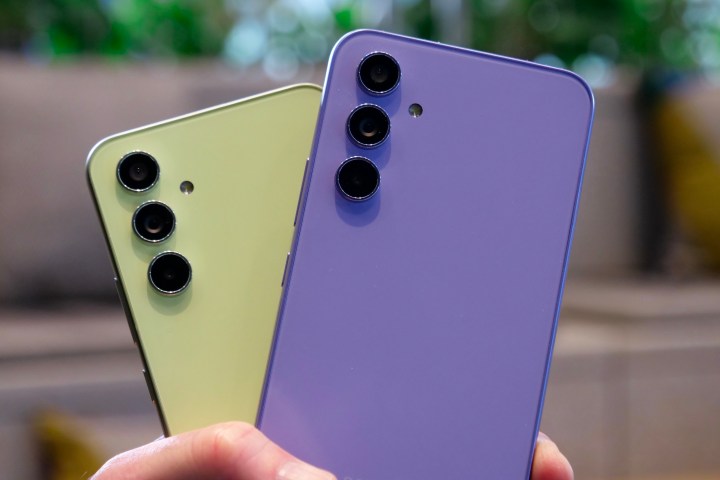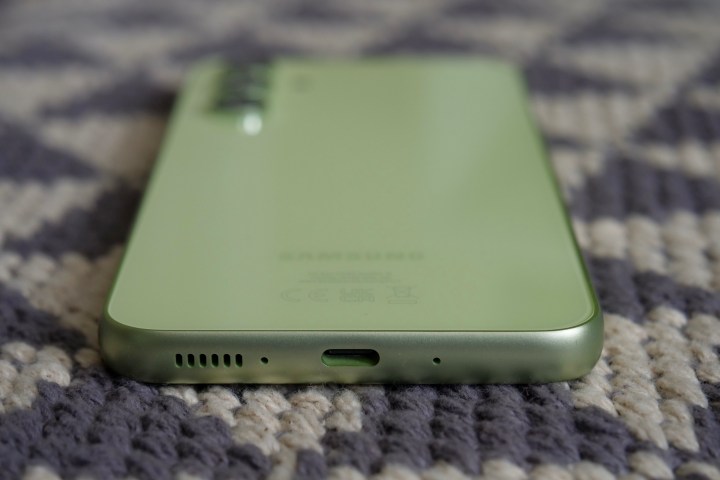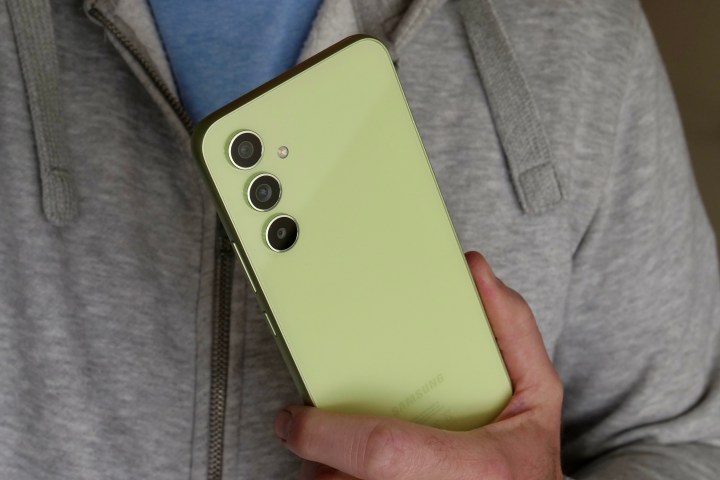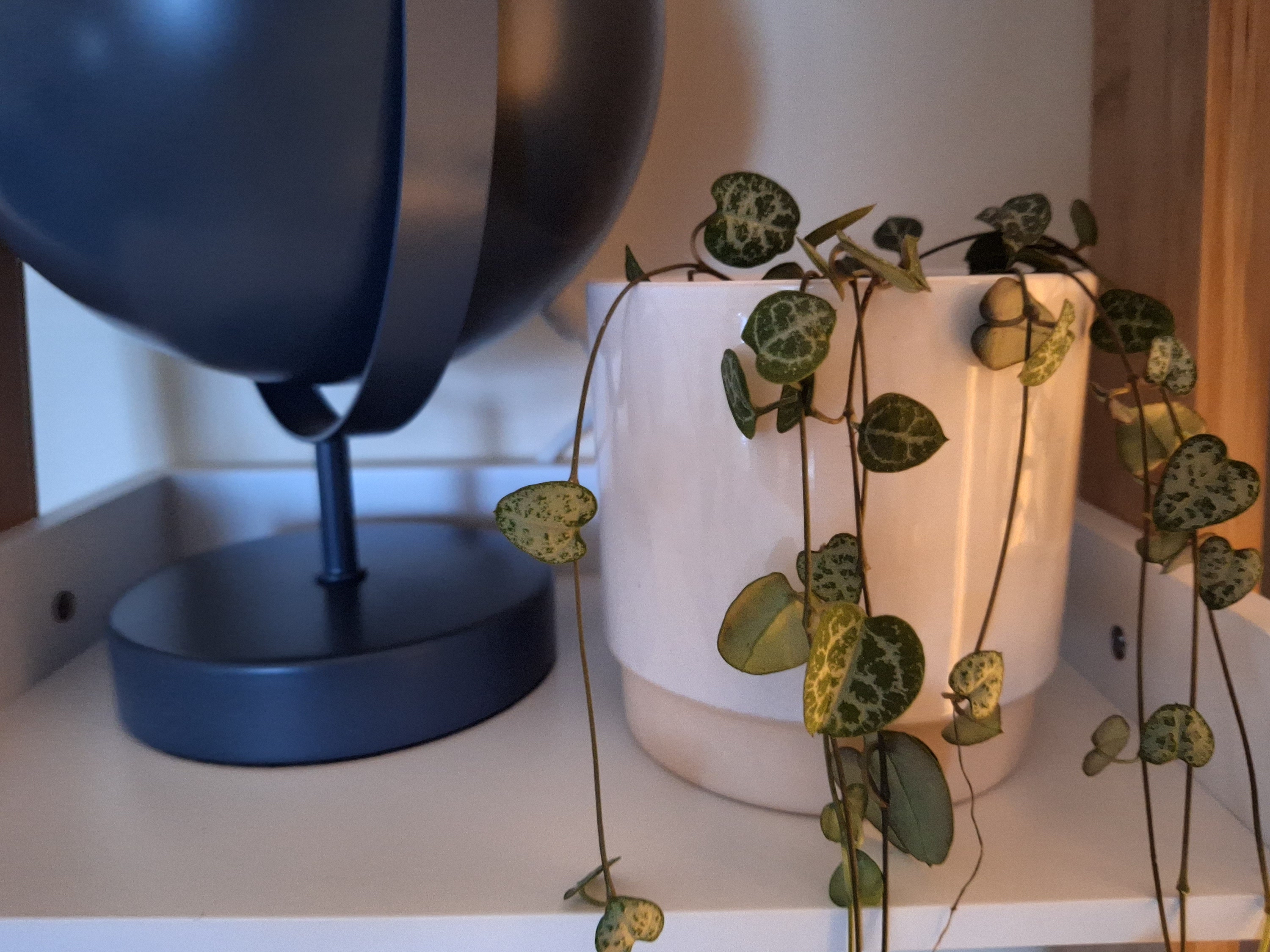“The Samsung Galaxy A54's colorful design and screen are matched by the colorful photos it takes, and while it's a sensible, good-value buy, it's let down by disappointing battery life.”
- Eye-catching colors
- It looks like the Galaxy S23
- Colorful screen
- Speakers sound good
- Long software commitment
- Battery doesn't last two days
- No wireless charging
- Camera lacks realism
Color is at the heart of the Galaxy A54. I’ll say this again in a few moments, but if you decide to buy the Samsung Galaxy A54, get it in bright purple or lime. It looks fantastic, and the colorful body matches the really colorful photos it takes — and the lovely screen too.
But should you consider buying it in the first place? I’ve had a very happy relationship with the Galaxy A54, and provided you ask yourself a pertinent question before handing over your money, I think you’ll like it. Let’s talk about why and that all-important question next.
Samsung Galaxy A54: design

The Samsung Galaxy A54 looks a lot like the Galaxy S23, which is no bad thing, particularly if you want flagship phone looks for mid-range money. However, the Galaxy S23 is slightly more compact than the Galaxy A54, which is taller, wider, and thicker at 8.2mm and 202 grams in weight. This is mostly due to the 6.4-inch screen, which is larger than the Galaxy S23’s 6.1-inch screen.
As I already mentioned, I love the Galaxy A54’s colors. There are the usual black and white versions available, but it’s absolutely worth injecting some actual color into your life with either the Violet or Lime versions. They really do look fantastic, and I’ve been using the Lime version for my review (but also loved the Violet version when I saw it ahead of the Galaxy A54’s launch). Pick one of these, and you’ll stand out from the crowd in the best way possible.

The screen and the back of the Galaxy A54 are covered in Gorilla Glass 5, while the chassis is made from plastic, and the mix is just right when you consider the price. The glass feels high quality, and the plastic frame feels durable. Add the IP67 water and dust resistance, and the Galaxy A54 should withstand some fairly tough everyday treatment. It’s not slippery in your hand, and although it’s fairly weighty, you never feel like it’s about to make a bid for freedom.
Anything that’s not so good? The flat screen is more reflective than I like, and it does get quite smeary, as does the glass on the back. The bezels around the screen are fairly prominent, but this is to be expected on a phone at this level, and the fingerprint sensor is set quite low on the screen. None of these are dealbreakers.

I’ve found the Galaxy A54 to be very easy to live with — from the phone’s size and dimensions to the way it feels in your hand, particularly the smooth taper where the chassis and glass meet to minimize any sharpness. It’s thoughtfully designed, has decent durability, and looks much like a phone that costs quite a lot more.
Oh, and it comes in two of the best colors seen on a phone in ages. What’s not to like?
Samsung Galaxy A54: screen

There’s not a huge amount of difference between the Galaxy A54 and Galaxy A53’s screen technology, apart from one particular feature. The maximum brightness has been increased to 1,000 nits compared to the A53’s 800-nit maximum, and the difference is very noticeable. Like the Galaxy S23 Ultra, the Galaxy A54’s screen jumps to its maximum in very bright conditions, and it makes it much easier to view. It’s immediately noticeable, particularly when taking photos outdoors, and a considerable benefit.
Outside of this, it’s a 6.4-inch Super AMOLED screen with a 120Hz refresh rate and HDR10+ certification, and it looks great with Samsung’s signature strong colors and contrast on display.

The high refresh rate is extremely important, and when you’ve tried a phone with a 90Hz or 120Hz refresh rate, you will never want to go back to a 60Hz refresh rate. It makes scrolling through the operating system, apps, and games smoother and easier on the eyes. At this price, don’t accept a phone without it.
Video and games look great, but special mention should go to the stereo speakers.
Video and games look great, but special mention should go to the stereo speakers. They have a very pleasant sound and provided you hold the phone in a way that doesn’t block them in landscape orientation, they project sound towards you really effectively. Great sound makes a real difference to a phone, and they genuinely enhance the Galaxy A54’s multimedia capability.
Samsung Galaxy A54: software and performance

Android 13 with One UI 5.1 is installed on the Galaxy A54, which is the same software you’ll find on the latest Galaxy S23 series, with the March 1, 2023, security patch at the time of writing. Samsung’s software update commitment is excellent; the Galaxy A54 will receive major updates for the next four years and security updates for the next five years.
I really like One UI, mostly because it’s smooth, fast, and for the most part, non-intrusive. There are plenty of features hidden inside, but they’re the right kind of features — such as the edge panel to show recent apps, routines that prompt actions based on your use and location, and access to Samsung’s Labs feature where you can experiment with different modes that are still in beta.
There’s nothing that feels overly superfluous, and if there is anything that’s a bit of a gimmick, it’s not shoved in your face until you’re forced to find a way for it to disappear. All my apps run without a problem, and it doesn’t appear to have restricted use drastically in order to conserve battery life. The setup is a little long-winded, with prompts to sign in with a Samsung account and advice to download unwanted apps, but that’s all. Calls sound good, I’ve had no problems with connectivity, and it pulls in a 5G signal without issue.
Performance comes from Samsung’s own Exynos 1380 processor, which is backed up by either 6GB or 8GB of RAM and 128GB or 256GB of internal storage space, plus there’s space for a MicroSD card too. It’s not blazing fast like the Galaxy S23 or the OnePlus 11, and the animations when opening apps and scrolling through the phone are a tiny bit ponderous, but it never feels slow. It’s perfectly fine for normal use, including games. I’ve played Asphalt 9: Legends enough to spot any slowdown or stutter, but there’s no evidence of anything that would spoil your enjoyment.

It’s not faultless, though. The camera app isn’t very fast at all, especially shooting in low light compared to other devices. It can also take a beat to react when you’re trying to multi-task, which can be frustrating. However, it’s not really made to do anything too strenuous. That said, I’m not convinced there’s much room for growth inside the Exynos 1380, so if you think your phone use will increase or you’ll want to play more power-intensive games in the future, it may not be able to keep up.
This is when a phone like the OnePlus 11 makes sense. It’s more money at $699, but not so much more that it could be considered out of reach. The specification means it’s far more future-proof than the Galaxy A54. It also brings the $599 Google Pixel 7 into play, as it is also more powerful and far better than the A54 when it comes to the camera, which we’ll talk about next.
Samsung Galaxy A54: camera

The Galaxy A54’s main camera has 50 megapixels and optical image stabilization (OIS), and it sits in between a 12MP wide-angle camera and a 5MP macro camera on the back of the phone. The (useless) depth camera from the Galaxy A53’s setup has been removed, and the overall design is cleaner and more attractive. The video mode shoots up to 4K resolution at 30 frames per second, and it now has digital image stabilization and intelligent reframing if it notices something happening at the edge of the frame.
Photos taken with the Galaxy A54 are likely to cause controversy. Samsung has long been associated with overly saturated colors, and it seems to have embraced this reputation with the Galaxy A54. The colors on display sometimes border on the insane, with reds, blues, and greens all amplified to a state that’s often out of control. I like a photo that pops, but not one that threatens to make my eyeballs explode with its intensity.
It can rob the Galaxy A54’s camera of realism, and because photos look relatively normal when the weather is a bit grey, the sudden retina-scorching colors in photos when the sun comes out are even more jarring. I don’t hate it, but it would benefit from a little toning down. I can see the A54’s sunny day performance appealing to those who love applying the most amped-up filter they can find on their photos, though. However, anyone who values natural tones and realism will, I suspect, absolutely hate it.
Put it against the Nothing Phone 1, and you can see where Samsung increases the saturation, taking it slightly beyond even the very color-orientated Phone 1’s camera. Results vary between the two when comparing the wide-angle cameras, too, with the Nothing Phone 1 providing more consistent shots.
The Galaxy A54’s camera is good, but it struggles with consistency and a lack of realism, while the selfie camera — despite having 32MP — doesn’t show much detail and washes faces out in difficult lighting.
If the camera really matters, and you don’t want to spend $1,000 or more, then consider the Google Pixel 7. It takes far superior and much more realistic photos than the Galaxy A54, and it’s more versatile too. The phone itself is a bigger question mark, as although I’ve had a great experience with Google’s latest phone, others have not been so lucky.
Samsung Galaxy A54: battery and charging

The Galaxy A54’s battery life has been a little disappointing, especially considering it’s a 5,000mAh cell inside the phone, and it’s not having to work all that hard to run the hardware. My daily use time hasn’t stretched much beyond three hours, with some days connected to a Galaxy Watch 5 Pro, and the battery consistently has less than 40% remaining in the late evening.
That’s not enough for two days’ use, and if you push the phone much harder, a full day is all you’ll get. Getting two days of battery out of the far more powerful Galaxy S23 Ultra is easy, and the Galaxy A54 really should be matching this, if not exceeding it. Considering the modest specification and the size of the battery, the reason it’s not lasting very long may come down to the efficiency of the Exynos processor.
Battery consumption varies, with watching 30 minutes of YouTube only taking 3% from the battery, and less than 10% after 30 minutes of gaming, which are both typical. But an hour’s WhatsApp video call over Wi-Fi saw more than 20% disappear. It makes judging the Galaxy A54’s daily performance a challenge.
You don’t get a charger in the box so you’ll have to use an existing one, or buy a Samsung-specific version. The phone will charge at speeds up to 25W. I’ve used the Anker 313 GaN charger and cable, which supports Samsung’s Super Fast Charging at up to 45W, and it takes 75 minutes to recharge the battery. After 30 minutes, the battery reaches around 65%, which should be enough for a day of modest use. Use a non-compatible charger, and it can take up to two hours to fully charge the Galaxy A54, plus the phone does not have wireless charging.
Samsung Galaxy A54: price and availability

The 6GB RAM/128GB Samsung Galaxy A54 is available to buy now for $450 through Samsung’s own online store, plus various carriers — including AT&T, T-Mobile, U.S. Cellular, and Verizon. It appears only the Violet and Graphite versions are available in the U.S. at the moment, and only the 6GB/128GB version is listed.
In the U.K., the 6GB/128GB version costs 449 British pounds, or around $561, and the 8GB/256GB version is 499 pounds, which is about $624. It’s available through various retailers and networks, plus Samsung’s online store, where all four colors are listed.
The Galaxy A54 is a very safe, sensible buy, even with its downsides.
The Galaxy A54’s price puts it against the Google Pixel 6a, which is a very good phone but is in imminent danger of being replaced by the rumored Google Pixel 7a. It’s cheaper than the cheapest competing Apple iPhone, the $599 iPhone 12, and superior to the aging iPhone SE (2022). The Galaxy A54 is a very safe, sensible buy, even with its downsides.
Samsung Galaxy A54: verdict

The Galaxy A54 has been my daily device with my main SIM card inside, so it has been called into action on everything from GPS navigation to photos, chats, calls, games, and app browsing. Nothing special about that, but I have been using it alongside the Apple iPhone 14 Pro and the Galaxy S23 Ultra.
I find that if a phone I’m reviewing has notable downsides or frustrations, I’ll reach for the other phones I have with me at the time just because I don’t want to deal with them. Despite the strength of the other devices in my bag, the Galaxy A54 hasn’t prompted me to grab either of its far more expensive peers. I’ve not even made a point of using the A54 — I just used it. That speaks volumes about the A54’s ability and software.
This is a great phone let down slightly by its disappointing battery life, the camera’s performance is sure to split opinions and I’m not sure there’s much more performance to give, raising questions about its longevity. It’s a shame when the phone’s software commitment is so strong. However, take the quality, software, durability, and design into account, and the Galaxy A54 becomes very appealing.
This brings me on to that important consideration and the question you must ask yourself before buying the Galaxy A54. It’s excellent, but if you spend a little more, the next steps up — the OnePlus 11, Google Pixel 7, and even a Galaxy S23 if you can find it on offer — are seriously good. They’ll also last you a lot longer than the Galaxy A54 on a hardware level, meaning the extra initial cost will be offset in the future. It’s a hard decision, but if you don’t want to spend more, the Galaxy A54 is a safe purchase you won’t regret, provided your requirements don’t change over time.

































